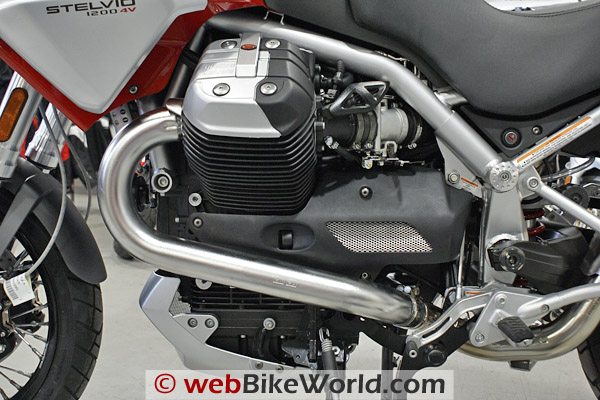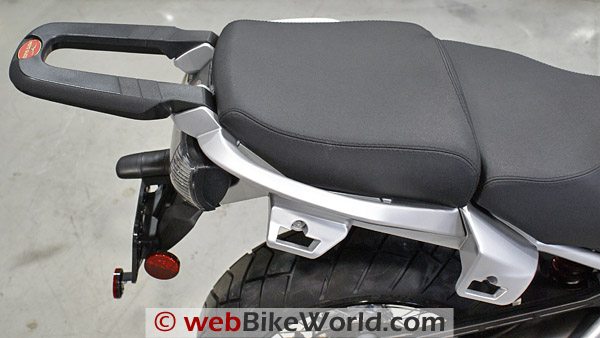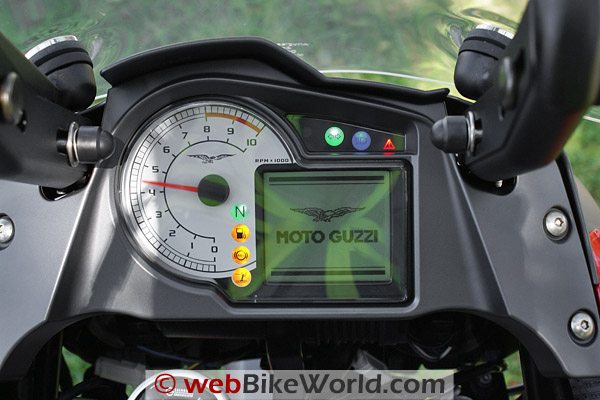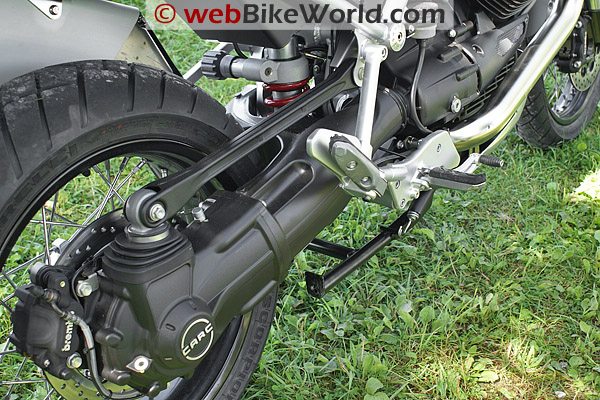Moto Guzzi Stelvio 1200 4V Ride Report
The Stelvio 1200 4V is here and it remains true to the Moto Guzzi heritage of building exciting motorcycles.
Whether it will become a modern classic remains to be seen; what can be confirmed from this ride review is that overall, it will not disappoint. Those wanting to experience what a big V-twin can provide in the way of power, forward propulsion, technology and the ability to go the distance should take a close look at the Stelvio.
The arrival of the new Moto Guzzi Stelvio was originally reported in this webBikeWorld feature articlein 2007. The motorcycle has finally arrived in North America and is just now filtering its way through the distribution pipeline.
Although my riding time was more limited than usual, the opportunity to gain essential data, validate or disprove my initial thoughts and, best of all, get some seat time was greatly appreciated. A big thank you to Gear Head for facilitating this review.
As a market offering, the big Guzzi with its distinctive-sounding 4V high output motor cannot be ignored. It has arrived on showroom floors with apparently little fanfare, which may or may not be a portent of the future for this new offering from a proud company that actively pursues its goals under the Piaggio Group banner.
Rightly or wrongly, real or perceived, the Stelvio has or is being categorized under the Adventure-Touring segment, based mostly on its design, appearance and marketing rather than an actual proven capability.
By the way, the bike is named after the Passo dello Stelvio, which at 2,757 metres is the highest paved mountain pass in the Eastern Alps and for Moto Guzzi, a historical test stretch.
So with all this in mind but keeping objectivity first and foremost, what follows is a relatively short but honest assessment of the Stelvio.

The Real Rumble
Anyone who has owned or ever ridden a Moto Guzzi can attest to the vibrant cadence of the engines. For many it is the heart and soul of a Moto Guzzi. Thankfully, that heart and soul is alive and well in the Stelvio’s 1200cc 4V.
The engine booms along and as the tachometer sweeps quickly up and over 4,200 RPM, the pulses smooth out, and at 5,000 rpm and above most of the pulsation is felt only in the solidly mounted handlebars.
For those not used to riding big V-twins or thumping singles, the pulsations might be somewhat tiring or even disconcerting. But for those who know, it is the feeling only experienced and savoured from a few engines – this is one of them.

Ergonomics
Slipping a leg over that massive engine and the high tensile tubular steel frame is pretty easy; seat height on the lowest setting is 820 cm or 32.3 inches, whereas the higher setting brings the seat up to 840 cm or 33 inches, the setting I found most comfortable given my 34 inch inseam.
Seat height is adjusted manually by inserting the left and right seat bracket cut-outs into one of two height adjusters at the front and then selecting one of two vertical holes at the rear in which to thread the removable screw knobs.
Compared to other height adjustment mechanisms seen, this one is stone simple. Be warned, however, that due to limited access, it is easy to drop one or both of the screw knobs during this adjustment procedure!
I did find that after all these years and several engine versions after my first Guzzi experience that my knees still touch the back surface of the heads…one reason why stylish black heat caps have been installed as the rear portion of the each head surface.
They do the job; while I could feel some heat coming from the cylinder area, my mesh riding pants never got overly warm in the knee area.
Both the rider and pillion seat sections are broad and firm and the large but well-shaped rider section proved very comfortable over a full day of riding. The supportive feel of the seat is helped in large by a heavy seat pan and very good cushioning. While stock seats are not always known for their adequacy, this one feels different – in a positive sense.
At around 550 lbs. (wet), the Stelvio is not a lightweight by any means, but it takes virtually no effort to push it off the centre stand or lever it up to vertical when using the side stand. Once moving, its weight becomes inconsequential.
The 910 mm (35.83 in) handlebar is a comfortable lever, but input effort is minimal – the Stelvio goes where it is pointed.

Controls and Features
In first seeing and then sitting on the Stelvio, it is impossible to not notice the mirrors. Apparently redesigned for the North American market, the mirrors are very oval in shape, on long stalks and now have the signal lights built in to the front face of each unit housing.
Whilst extremely functional, the mirrors stick out at least three inches beyond the bars while the external wire harnesses detract from what is otherwise a pretty tidy handlebar environment.
The European-spec Stelvio has a much cleaner profile with smaller but extremely functional mirrors and flush-mounted signal lights on the lower side flares of the fairing.
The Stelvio has a combination of analog and digital information displays to rival anything else on the market, all packaged in one neat instrumentation and information pod. A large analog sweep tachometer dominates the left and centre portion while the multi- function digital display LCD sits in the lower right quadrant.
As with most Piaggio Group products, the information displays are very comprehensive and easy to use, once the owner’s manual is read once – or twice. The main information display is accessed by toggling the large “Mode” switch on the left hand control.
The left hand control also houses the horn button and a standard left/right/push-to-cancel switch, which has an extremely smooth feel. On the top front of this control is the headlight Hi/Lo/Flasher rocker switch, and below it is the electronic release for the right-hand fairing compartment.
A combined kill-switch/starter button is found on the right-hand control, along with the Hazard Light button and the ABS button where available (and if so fitted). A supplemental switch for Moto Guzzi accessory lighting resides on the top front of the housing.
Another standardized and shared feature is the key-based immobilizer system. Two coded keys are provided, although up to four keys can be coded from the same secure settings loaded on to the onboard system and accessed via a special security code.
Speaking of access, the saddle compartment keyhole is located on the lower left side of the motorcycle. Using the ignition key, the cable-activated switch releases the rear seat lock, allowing the rear section to be lifted up and off. This under-seat area features a large storage box for holding the small tool pouch, the owner’s manual and other stuff.
A North American style power plug, seemingly fitted as an add-on, is installed in the right front wall of the storage box (see photo). It is rated for up to 180W, but given its location, it is not easily accessible – some long accessory power cables will be needed. One or two externally-mounted DIN power plugs would be a far better option for fitment, and use.
The glove compartment on the right fairing is long, narrow and quite deep – best suited for extra gloves, sunglasses or other small sundry items. With the motorcycle in neutral and the ignition switch turned on, pushing the small electric switch on the lower front of the left hand control opens the lid. Closing the unit, however, results in a less than weather-proof seal.

Road Gear = Good
The Stelvio’s suspension is hefty – the front end features a 50mm inverted hydraulic front fork with preload and spring adjustment, while the rear features a single shock absorber with adjustable rebound and spring preloading, and both are easily accessible.
Everything was left on the default factory settings for the evaluation, which proved to be a good choice for the mixed road conditions encountered.
True to tradition, the massive single-sided swingarm assembly that houses the CA.R.C. (Cardano Reattivo Compatto or Compact Reactive Shaft Drive) drive system is both pleasing to the eye and extremely robust. This latest iteration is without a doubt one of the best shaft drive systems I have experienced.
While this right side assembly should allow a clear view of the left side, the massive combination catalytic converter and exhaust can assembly blocks much of the view on the left, which is unfortunate.
Ignoring the categorizations already performed by so many in the media, the choice of wheels and tires for the Stelvio says much about the intended use of the motorcycle itself. Pirelli Scorpion Sync tires are installed on lightweight aluminum rims with heavy duty Alpina spokes, providing a tubeless environment for the 110/80 ZR19 front and 180/55 ZR17 rear tires.
Acknowledging this somewhat unique tire configuration, everything just plain works. The Stelvio is on rails as it hustles through the turns, whoops and dips put in front of it. It never felt unstable or twitchy when pushed hard through some good corners at speed.
In striving to keep this new machine under a certain redline – not an easy task with the quick revving engine – its ultimate high speed prowess was not determined. But even with an artificial limitation imposed, the big twin builds speed in a hurry and its bulk is never an issue.
Environmentals
Like other European produced motorcycles, the Stelvio meets Euro 3 emission standards. As well, to meet EPA and CARB requirements, the now familiar California Evaporative Emission System is fitted. But unlike other model fittings, this installation is unobtrusive, being mounted under the front fairing and just visible to the rider.
The system has a five year or 30,000km warranty (whichever occurs first).
Windscreen Woes
The windscreen is probably the Stelvio’s weakest component in both protecting the rider and passenger and from an appearance point of view.
Although a small screen can still be very effective if it is well designed (i.e., MRA Vario Touring Shield, BMW R1200GS Windscreen, etc), this one, at least for me, misses the mark.
Manually adjustable through a 5.5 cm (2.0 in) range, only the lowest setting provided a relatively calm cockpit environment. With the helmet in the airstream, there was minimal buffeting on the sides and along the bottom of the helmet.
Moving the windscreen up higher resulted in less direct air pressure but greatly increased buffeting on the top, sides and bottom of the rider’s helmet, which translates into noise, and discomfort. It is understandable that the development team wanted to keep the Stelvio windscreen small so as to fit in with the overall narrow front profile, despite the bug-eyed look of the headlights.
But, a redesigned windscreen is needed. In any case, it is no doubt already being addressed by the accessory market.

Conclusion
Despite the limited time and distance spent riding the Stelvio, the experience was extremely positive. In my opinion, as someone who owns or has owned most of the larger adventure-touring machines, this big V-twin is faster and more agile than most.
The eight valve motor makes twisting the throttle an absolute blast. Based on my seat-of-the-pants assessment, it definitely won’t be bringing up the rear and would most likely be in the lead, or at least pushing the leader…
Outside of the pretty obvious “adopted for the North American market” changes, the poor windscreen and some vibration, little criticism of this new Moto Guzzi model can be put forth at this time.
As the kilometres rolled on, vibration felt through the handlebars was already starting to smooth out across the RPM range. The bar-end weights obviously help, although some sort of isolation mounting for the bars would work wonders without compromising input and feedback.
This machine is built to be used hard and to cover large distances. Whether it has the form, or adaptability, to undertake serious off-road adventure touring activities and directly challenge the current crop of players remains to be seen. Stay tuned…
More: Moto Guzzi Stelvio information, technical specifications, video and photos. Also, be sure to read our overview on the other new 2008 Moto Guzzis.
| Ride Report: Moto Guzzi Stelvio | |
| Available From: Moto Guzzi International | Suggested Retail Price: $17,595.00 (CAD) |
| Colors: Red or Black. | Made in: Italy |
Product Comments: Photos by the Author, taken at Gear Head Canada (Ottawa) and Calabogie Highlands district (Ontario). Review Date: August 2008 (Published September 2008).Moto Guzzi Stevio 1200 4V Basic Specifications (More)
|
|
Note: For informational use only. All material and photographs are Copyright © webWorld International, LLC – 2000-2011. All rights reserved. See the webBikeWorld® Site Info page. NOTE: Product specifications, features and details may change or differ from our descriptions. Always check before purchasing. Read the Terms and Conditions!
Owner Comments and Feedback
Not all comments will be published (details). Comments may be edited for clarity prior to publication



No Comment